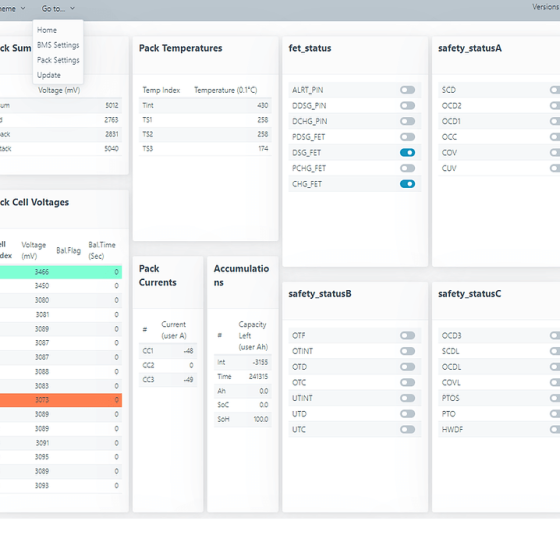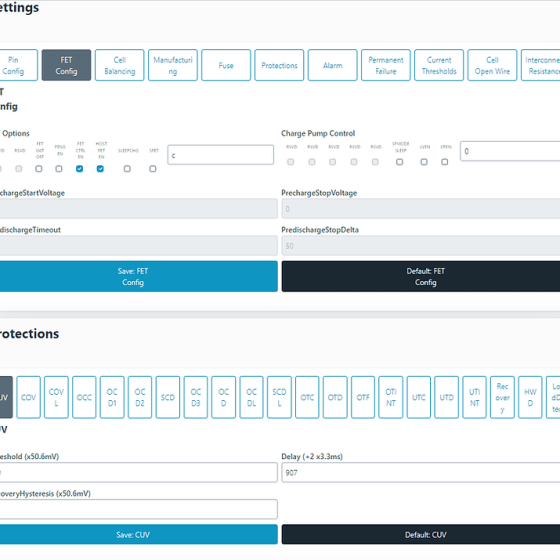Battery Management Systems
Battery Management, Inspection & Charger Systems for Micro Mobility
BMSLion is a modular Lithium battery management system designed to monitor and control up to 16 series of lithium cells. Thanks to its modular structure multiple modules can be used to manage from 12V to very high voltage lithium packs suitable for Electric Vehicles and Large Energy Storage Systems…

BMSLion v3: Lithium Battery Management
Lithium battery cells are used in series to store at higher voltage in many applications. Depending on the lithium cell chemistry, cell voltages range between 2 and 4.5 V (LiS:2.1V, LFP:3.2V LCO/ NMC/ LCA: 3.7V).
Series-connected cells are charged and discharged through a single current path. The task of monitoring the cell voltages and temperatures, especially during charging, and ensuring that the limit values are not exceeded is performed by the “Battery Management System”.
BMSlion v3 monitors all the parameters of the cells in the battery pack consisting of series-connected lithium cells and ensures that the values remain within the determined limits by analyzing the data. If the limit values are exceeded, it cuts the charge/discharge current to prevent damage to the cells.
BMSLion v3 System Structure
The GBMS (Global Battery Management System) card inside the module provides monitoring, protection, and balancing functions with embedded software algorithms running on a 32-Bit Wireless microcontroller module.
GBMS can measure the package voltages of up to 16 cells and the temperatures of up to 8 cells with probe cables. GBMS can open and close the MOSFETs on the CDC (Charge Discharge Control) module that can be connected to its connector. Through the same interface, it can also drive contactor coils that open and close higher currents.
The BMSLion v3 System not only “monitors” the battery pack but also “balances” the voltage differences between cells. In the passive balancing option, it discharges high voltage cells through a resistor (150…380mA).
The BMSLion v3 System can drive external contactors that can cut the charge (CHG) and discharge (DSG) current for high-current applications. Additionally, it can also control the “Predischarge” feature by driving the PRE relay.
- Physical Dimensions: PCBA: 120 x 80 x 22mm (D x W x H), Enclosed: 130 x 88 x 24mm
- Weight: Card: 65 g, Enclosed: 300 g
- Electrical: Supply voltage: 12 – 72 VDC
- Environmental: Operating Temperature: -20 – 55°C
- Environmental: Relative Humidity: 90% RH
- Can measure cell voltage from 3-16 ports with 1-2 mV accuracy (0.5 – 4.5V)
- Cell Balancing Method: “Passive Balancing” (150 or 380 mA balancing current)
- Cell Protection Features: If any cell exceeds the “Over Voltage Protection” (COV 2.5 – 4.5V adjustable) value during charging or drops below the “Under Voltage Protection” (CUV 0.5 – 3.0V adjustable) voltage during discharging, the current is cut off.
- MicroSD Interface: Logs system logs onto MicroSD card memory and log file can be downloaded in CSV format from Wi-Fi Web interface.
- Can transfer data to remote servers over Wi-Fi via TCP/IP protocols. Data can be monitored from a Web browser on Phone/Tablet/PC via embedded web server.
- Notifies the user of system status and alarms with RGB LED.
- Measures cell temperatures with 3-port NTC type temperature sensor. NTC can be increased to 8.
- Can open and close charge/discharge power MOSFET or contactors with 2-port MOSFET driver (<5A pull down).
- Can perform PRE-Charge/Discharge (<1A) function with 2-port High Side MOSFET switch.
- Can read the package current as voltage from the Hall Effect Current Sensor.
- Can read the package current as voltage from 1-5 mOhm Shunt current sensor.
- Can communicate with management systems via RS485 interface.
- Can communicate with Inverter and PCS or electric vehicle ECU/VMS units via CAN-Bus interface.
Remote Monitoring and Management of BMSLion v3
The BMSLion v3 has a TCP/IP interface accessible via Wi-Fi. Through standard protocols such as “Internet of Things – IoT” (MQTT) and MODBUS-TCP over Wi-Fi, it regularly transmits data, statuses, and alarms related to the battery pack to the cloud IoT server called ReMon.
By connecting a MicroSD Memory to the MicroSD type connector on BMSLion v3, it is possible to store (Log) the data generated during the operation of the battery pack and later examine it on a PC. Users connected to the ReMon server can monitor remote BMSLion v3 systems or generate historical reports.
Communication over RS-485 MODBUS is possible through the RS-485 driver on the GBMS.
The BMSLion v3 modules can be used in “Dual-BMS” form to manage lithium packages connected in series from 16 to 32. In this structure, each GBMS manages 3-16 cells connected to it, while one GBMS in the package becomes the “Master” and communicates with the other Slave GBMS via Wi-Fi, taking over the entire management and charge/discharge current control of the 32s package.
The GBMS card can detect and control external signals with analog and digital input-output pins.
Real-time measured data by the GBMS can be monitored by the user and the card settings can be adjusted through the web interface accessible via Wi-Fi.

BMSLion v3 GCDC (Charge/Discharge Control)
BMSLion v3 can operate by driving contactors or by driving the MOSFET switches on our “Charge Discharge Control card” called GCDC. By driving the parallel Charge and Discharge switching MOSFETs on the CDC in High Side mode, it can cut the desired direction of current when necessary. It can read the current from the Hall Effect Current sensor on the CDC, which can measure up to 100A.
BMSLion v3 Embedded Web Interface
The BMSLion v3 module continuously or when its button is pressed, activates its Wi-Fi SSID. After connecting to this SSID with devices such as a Mobile Phone, Tablet, or Notebook PC via Wi-Fi, the embedded web interface seen below can be accessed by opening a web browser and entering the BMSLion IP number 192.168.4.1. On the “Home” page, the system’s instant measurement information can be seen, while the system’s parameter settings can be made by accessing the “BMS Setting” menus after username/password control. No special software or cable is required to program the system. All operations can be done wirelessly.
 English
English Türkçe
Türkçe




